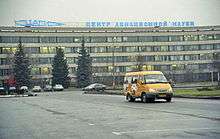Central Aerohydrodynamic Institute
The Central Aerohydrodynamic Institute (Russian: Центра́льный аэрогидродинами́ческий институ́т, ЦАГИ, romanized: Tsentralniy Aerogidrodinamicheskiy Institut, TsAGI) was founded in Moscow by Russian aviation pioneer Nikolai Yegorovich Zhukovsky on December 1, 1918.
Native name | Центра́льный аэрогидродинами́ческий институ́т имени профессора Н. Е. Жуковского |
|---|---|
| federal state unitary enterprise | |
| Industry | aerospace |
| Founded | 1918 |
| Founder | Nikolay Zhukovsky |
| Headquarters | , |
Area served | worldwide |
Key people |
|
| Owner | Russian Federation |
Number of employees | 4392 (2013) |
| Website | tsagi |


History
From 1925 and up to the 1930s, TsAGI developed and hosted Tupolev's AGOS (Aviatziya, Gidroaviatziya i Opytnoye Stroitelstvo, the "Aviation, Hydroaviation, and Experimental Construction"), the first aircraft design bureau in Soviet Union, and at the time the main one.[1] In 1930, two other major aircraft design bureaus in the country were the Ilyushin's TsKB (Tsentralnoye Konstruksionnoye Byuro means "Central Design Bureau") and an independent, short-lived Kalinin's team in Kharkiv.[1]
In 1935 TsAGI was partly relocated to the former dacha settlement Otdykh (literally, "Relaxation") converted to the new urban-type settlement Stakhanovo. It was named after Alexey Stakhanov, a famous Soviet miner. On April 23, 1947, the settlement was granted town status and renamed to Zhukovsky. The Moscow branch of the institute is known Moscow complex of TsAGI.
In 1965 in Zhukovsky a Department of Aeromechanics and Flight Engineering of MIPT was established with support of TsAGI's research and knowledge base to educate young specialists for aerospace industry.
Among TsAGI's developments are the participation in the rocket Energia and the Space Shuttle Buran projects.
In 2013 TsAGI developed a testbench for high-speed compound helicopters with propellers.[2]
Heads of the institute
- 1918–1921: N. Y. Zhukovsky
- 1921–1931: S. A. Chaplygin
- 1932–1937: N. M. Kharlamov
- 1938–1939: M. N. Shulzhenko
- 1940–1941: I. F. Petrov
- 1941–1950: S. N. Shishkin
- 1950–1960: A. I. Makarevsky
- 1960–1967: V. M. Myasishchev
- 1967–1989: G. P. Swischjov
- 1989–1995: G I. Zagaynov
- 1995–1998: V. Ja. Neuland
- 1998–2006: V. G. Dmitriyev
- 2006–2007: V. A. Kargopoltsev
- 2007–2009: S. L. Chernyshev
- 2009–2015: B. S. Aljoshin
- 2015–2018: S. L. Chernyshev
- August 2018–present: K. I. Sypalo
References
- Albrecht, Ulrich; Nikutta, Randolph (October 1993). The Soviet armaments industry. pp. 15–16. ISBN 978-3-7186-5313-3.
- TsAGI has created a unique test bench for testing high-speed helicopters TsAGI, 13 December 2013
External links
| Wikimedia Commons has media related to TsAGI. |
- Historical video to celebrate first 100 years of TsAGI
- TsAGI in the Buran programme
- TsAGI on Google Maps